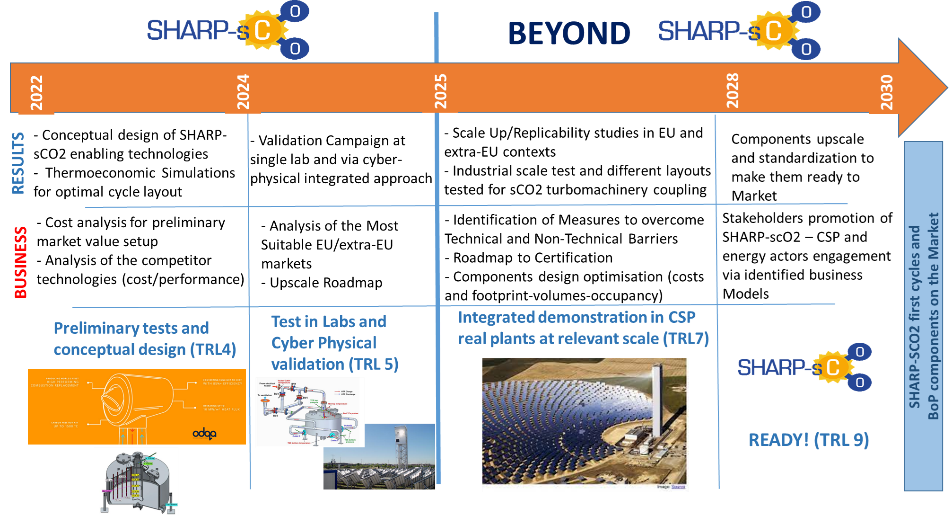SHARP-SCO2 – Solar Hybrid Air-sCO2 Power Plants
SHARP-sCO2 addresses key technological challenges to enable the development of a new generation of highly efficient and flexible CSP plants. Keeping on working with CSP-sCO2 power cycles and investigating how to exploit air as operating fluid, SHARP-sCO2 will develop and validate novel enabling technologies in EU top level labs. SHARP-sCO2 will attain high temperatures and cycle efficiency, while guaranteeing reliable and flexible operation. Introducing a smart hybridization with PV by means of an innovative electric heaters, SHARP-sCO2 will maximize sCO2 operation and remuneration, exploiting PV affordability while counting on the unique energy storage capabilities of CSP.

Background
The state-of-the-art CSP system is the molten-salt solar tower, which uses solar salt (HTF) at temperatures up to 570 °C. EU SET Plan [1] and agendas target significant cost reductions, coupled with the new development of HTFs, storage technologies and power systems able to reach thermal efficiencies higher than 50%. Evolving from 570 °C to higher temperatures, however, will require a new HTF, owing to traditional solar salt degradation at around 600 °C. Furthermore, advanced power cycles more flexible and able to operate at higher temperatures, and with higher efficiencies, must be used to achieve the LCOE objective. Each technology shift (e.g. HTF, TES, and power block) will have consequences on the CSP plant, with high risk for developers and financiers. Therefore, a step-wise approach where key sub-systems and components of the novel system are individually developed, optimized and tested prior to their full integration is of utmost necessity to push new innovations in CSP [2]. Such approach allows assessing technologies under controlled environments where external boundary conditions can be emulated (e.g. weather), and where components can be optimized gradually by progressively testing these at more challenging operating conditions (e.g. temperature and pressure) and under a number of cycles, while simultaneously allowing for data to simulate and evaluate integration and control aspects. Financing high-risk technologies is highly challenging, and progressing towards the EU SET goals in steps that the CSP industry members can support and implement is essential for the health of the industry and the commercial viability of newly developed technologies.
Aim and objectives
- Develop and validate (via a cyber-physical cycle approach) at TRL 5 an innovative air-driven CSP cycle to be hybridized with PV towards LCOE minimization.
- Develop, model, prototype and validate enabling technologies (receiver, storage, electric heater, sCO2-air HEX) both at single component level and in a cyber-physical integrated approach
- Minimize the impact of the SHARP-sCO2 solution by maximizing its circularity by design and proving that air-driven/sCO2 CSP cycles could be more socially/Stakeholders accepted and replicated
- Promote SHARP-sCO2 solutions in EU and extra-EU also to facilitate marketability
KTH coordinates the project and is the main responsible for the development of the thermal energy storage unit. SHARP-sCO2 overall view and pathway to market are summarized in the figure below.


Project partners
KTH Royal Institute of Technology (SWE);
RINA Consulting SpA (ITA);
Odqa Renewable Energy Technologies Limited UK (UK);
The University Of Oxford (UK);
Fundacion IMDEA Energia (ES);
Technische Universitaet Dresden (DE);
SEICO Heizunge Gmbh (DE);
Ethniko Kentro Erevnas Kai Technologikis Anaptyxis – CERTH (EL);
Università degli Studi di Genova (ITA);
Moroccan Agency For Solar Energy SA (MO).
Funding is provided by European Union’s HORIZON EUROPE Research and Innovation Programme under the Grant Agreement No: 101083899.
Timeframe: 2022 - 2025
Publications
Innovation trends on high-temperature thermal energy storage to defossilize energy systems
Researchers
For further information about this project, please contact Silvia Trevisan , Rafael Guedez
References
[1] Commission E. SET-Plan - Declaration on Strategic Targets in the context of an Initiative for Global Leadership in Solar Thermal Electricity ( CSP / STE ) 2015.
[2] Turchi CS, Ma Z, Neises TW, Wagner MJ. Thermodynamic Study of Advanced Supercritical Carbon Dioxide Power Cycles for Concentrating Solar Power Systems 2013. https://doi.org/10.1115/1.4024030.
